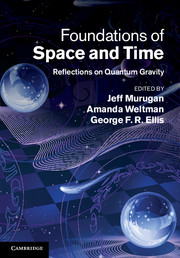Book contents
- Frontmatter
- Contents
- List of contributors
- 1 The problem with quantum gravity
- 2 A dialogue on the nature of gravity
- 3 Effective theories and modifications of gravity
- 4 The small-scale structure of spacetime
- 5 Ultraviolet divergences in supersymmetric theories
- 6 Cosmological quantum billiards
- 7 Progress in RNS string theory and pure spinors
- 8 Recent trends in superstring phenomenology
- 9 Emergent spacetime
- 10 Loop quantum gravity
- 11 Loop quantum gravity and cosmology
- 12 The microscopic dynamics of quantum space as a group field theory
- 13 Causal dynamical triangulations and the quest for quantum gravity
- 14 Proper time is stochastic time in 2D quantum gravity
- 15 Logic is to the quantum as geometry is to gravity
- 16 Causal sets: discreteness without symmetry breaking
- 17 The Big Bang, quantum gravity and black-hole information loss
- 18 Conversations in string theory
- Index
- References
2 - A dialogue on the nature of gravity
Published online by Cambridge University Press: 05 August 2012
- Frontmatter
- Contents
- List of contributors
- 1 The problem with quantum gravity
- 2 A dialogue on the nature of gravity
- 3 Effective theories and modifications of gravity
- 4 The small-scale structure of spacetime
- 5 Ultraviolet divergences in supersymmetric theories
- 6 Cosmological quantum billiards
- 7 Progress in RNS string theory and pure spinors
- 8 Recent trends in superstring phenomenology
- 9 Emergent spacetime
- 10 Loop quantum gravity
- 11 Loop quantum gravity and cosmology
- 12 The microscopic dynamics of quantum space as a group field theory
- 13 Causal dynamical triangulations and the quest for quantum gravity
- 14 Proper time is stochastic time in 2D quantum gravity
- 15 Logic is to the quantum as geometry is to gravity
- 16 Causal sets: discreteness without symmetry breaking
- 17 The Big Bang, quantum gravity and black-hole information loss
- 18 Conversations in string theory
- Index
- References
Summary
I describe the conceptual and mathematical basis of an approach which describes gravity as an emergent phenomenon. Combining the principle of equivalence and the principle of general covariance with known properties of local Rindler horizons, perceived by observers accelerated with respect to local inertial frames, one can provide a thermodynamic reinterpretation of the field equations describing gravity in any diffeomorphism-invariant theory. This fact, in turn, leads us to the possibility of deriving the field equations of gravity by maximizing a suitably defined entropy functional, without using the metric tensor as a dynamical variable. The approach synthesizes concepts from quantum theory, thermodynamics and gravity, leading to a fresh perspective on the nature of gravity. The description is presented here in the form of a dialogue, thereby addressing several frequently asked questions.
What is it all about?
Harold: For quite some time now, you have been talking about ‘gravity being an emergent phenomenon’ and a ‘thermodynamic perspective on gravity’. This is quite different from the conventional point of view in which gravity is a fundamental interaction and spacetime thermodynamics of, say, black holes is a particular result which can be derived in a specific context. Honestly, while I find your papers fascinating I am not clear about the broad picture you are trying to convey. Maybe you could begin by clarifying what this is all about, before we plunge into the details? What is the roadmap, so to speak?
Me: To begin with, I will show you that the equations of motion describing gravity in any diffeomorphism-invariant theory can be given [2] a suggestive thermodynamic reinterpretation (Sections 2.2, 2.3).
- Type
- Chapter
- Information
- Foundations of Space and TimeReflections on Quantum Gravity, pp. 8 - 49Publisher: Cambridge University PressPrint publication year: 2012
References
- 2
- Cited by



